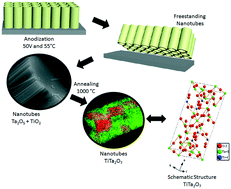Syntheses and structural understanding of a Ti–Ta alloy-based nanotubular oxide photocatalyst†
Abstract
Herein, we have synthesized Ti–Ta based mixed oxide vertically oriented and highly ordered freestanding nanotubes having an average length of 60 μm by anodic oxidation of a homemade Ti–Ta (50–50 at%) alloy. The effect of heat treatment on the morphology, phase transformation to TiTa2O7 nanostructures, crystalline structures, optical and surface properties has been investigated by a variety of characterization techniques. The samples remained mainly amorphous at temperatures up to 700 °C, and according to the Rietveld refinement analyses the bulk formation of crystalline Ta2O5 and TiO2-anatase phases occurred only at 800 °C in the tubular matrix followed by a slight solid to solid transformation of TiTa2O7 and TiO2-rutile phases starting from 850 °C. At 1000 °C, the content of TiTa2O7 increased followed by a decrease in TiO2 and Ta2O5 content; however, the nanotubes appeared to be interconnected particles imitating the verticality of the nanotubes. Compared to the literature (∼1350 °C), in this work the transformation of TiTa2O7 occurred at a lower temperature which is related to the amorphous nature of the starting nanotubular samples. The HAADF-STEM images and localized EDS mapping showed the distribution of Ti and Ta elements along the tubular matrix demonstrating that the as-anodized nanotubes consist of a uniform mixture of TiO2 and Ta2O5 whereas for the calcined samples random distribution of Ti was observed indicating the migration of Ti inside the tubular matrix for the formation of mixed oxide and TiTa2O7 phases. X-ray photoelectron spectroscopy (XPS) analysis identified the dislocation in the binding energies of Ti 2p and Ta 4f regions for the heat treated samples as compared to the as-anodized nanotubes; related to the formation of TiTa2O7. The optical band gap of TiTa2O7 was found to be 3.08 eV. These oxide mixtures were applied in photocatalytic H2 generation under solar irradiation; where the sample heat treated at 1000 °C has resulted in a production rate of 41.58 μmol h−1 g−1 which was higher than all the other samples synthesized in this work. For continuous 48 h irradiation the photocatalytic activity of the sample remained highly stable. This result is related to the higher content and lower bandgap energy of TiTa2O7 in the mixed oxide matrix indicating that TiTa2O7 is a promising photocatalyst.



 Please wait while we load your content...
Please wait while we load your content...